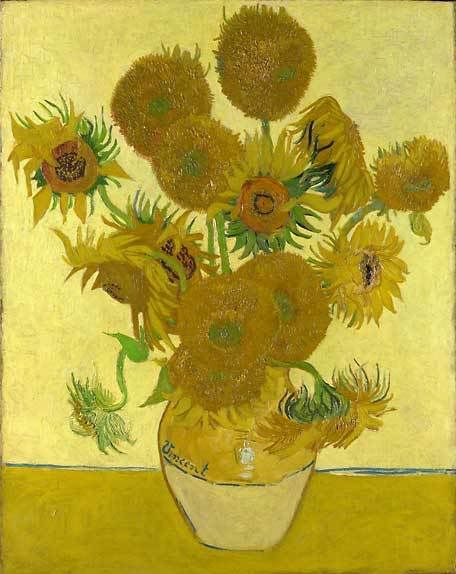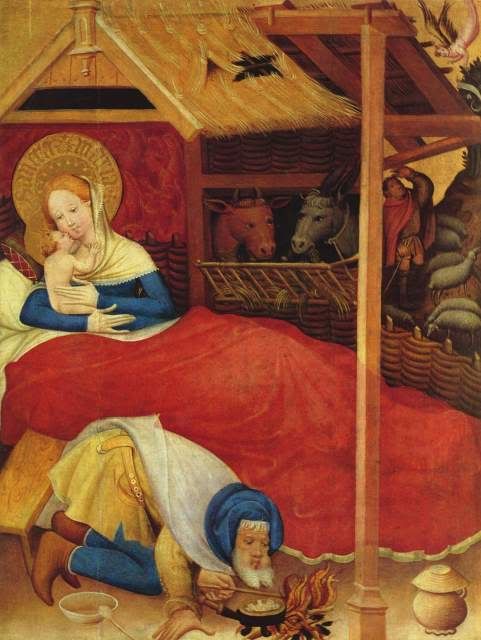
Here's a truly "Pre-Raphaelite" painting for you all! This Nativity scene was painted by Conrad von Soest in 1403. Von Soest, who was born in 1370 in Dortmund, was considered one of the greatest artists in Westphalia. He introduced the "International Courtly Style" of art to Northern Germany, and influenced Northern European art throughout the 15th century.
This image captured my eye because of its domesticity! For one thing, it was the first time I'd seen a nativity scene that featured Joseph cooking for his new family! Mary and Jesus look so tender as well (get a closer look at the expressions on their faces, and you'll know what I mean!).
Perhaps it's because this is my first Christmas with a little baby of my own, but this year I wanted to see rather more familial tenderness and a bit less distanced adoration among the Holy Family. No doubt Charles Dickens (who considered Milais' "Christ in the House of His Parents" sacrilegious for its frank portrayal of Christ's family) wouldn't have been very impressed with von Soest's more familial portrayal of the Nativity scene, but I'm sure the Pre-Raphaelites would have loved it!
On a side note, I find the ahistorical touches, such as the medieval clothing and any number of details in the painting, rather charming. Besides, I sometimes wonder if medieval artists were just trying to make historical paintings approachable for their audience. Perhaps by giving historical figures contemporary clothing and accoutrements, von Soest was ensuring that his audience would spend less time wondering why Mary and Joseph were wearing funny clothes! (what modern child didn't grow up asking their parents why Joseph ran around in a skirt and sandals all the time - I know I did!).
Happy Holidays to all, and much prosperity and happiness in the New Year!
Image courtesy of Wikipedia.
Thursday, December 24, 2009
Happy Holidays!
Posted by
Margaret
at
10:51 AM
3
comments
![]()
![]()
Thursday, December 10, 2009
Blue Italian made in England once again

Some of you will recall that I was devastated when Spode went bankrupt last year. Blue Italian was my wedding china pattern. I fell in love with the design the first time I saw it, and I started collecting it for my hope chest when I was about 12 years old (yes, I'm a little old fashioned, if you haven't gathered that from this blog so far!). I still remember asking for Blue Italian pieces every year for Christmas and for my birthday!
Spode was a multi-generational thing in my family. My dad's mom collected blue and white china, and had a beautiful set that I used to look at for hours in our china cabinet back at home. My mother was also in love with blue and white. I remember treasuring every one of Victoria Magazine's "Blue and White" issues - I felt like they had been especially designed for me! Now that I have a little girl of my own, I can't help but hope that she shares my love for the colour combination.
Over the past several months, I had given up on Spode - especially after receiving a shipment of horrible quality Blue Italian that had been manufactured in China. Fortunately, one Earthly Paradise reader--James, from Staffordshire--stayed on top of the story. He had originally commented on my post "The End of an Era--Spode Begins Overseas Production" . Last Thursday, he left an update on the company that was so good that I've decided to reproduce it here in its entirety. Thanks to huge disappointment with the quality of the made-in-China Blue Italian, Portmeirion is once again manufacturing Blue Italian in Staffordshire!
Even more months on now, and over a year since Spode called in the administrators.
A lot of people will know this by now. The trade names and intellectual property rights of Royal Worcester and Spode were purchased by the Portmeirion Group of Stoke-on-Trent in April 2009. The historic Church Street site, alas, was not part of the deal. Ceramics will never be made there again, ending a 240 year old era during which the finest wares in the world were produced.
Spode lost it's Royal Warrant, held since 1806, upon ceasing trading. Spode produced the china for the Titanic, the Queen Mary, British and European aristocracy, and of course, the British Royal Family.
The Spode museum and archives, a separate entity from the business, was moved to Stoke-on-Trent City Museum.
Now for a bit of good news. Go to www.spode.co.uk and you will see that Portmeirion has started making "Italian" again in Stoke-on-Trent! "Stafford Flowers" has also just been re-introduced. "Woodland" and "Christmas Tree" are also in production; the latter in China, unfortunately. But Portmeirion (one of the few genuine success stories in the tableware industry) is committed to bringing back production to Staffordshire, partly in response to the huge backlash against cheap imports from Asia.
For me, however, as a Spode collector of 30 years, things will never be the same again. Spode which comes from anywhere other than that wonderful site on Church Street in Stoke-on-Trent just isn't Spode. It was my favourite place on Earth, and I still haven't got over the events of the last 12 months.
Oh, I forgot to add that most of the Church Street site contains buildings which are "listed" by English Heritage (a government agency). What this means is they are of exceptional architectural and historical significance, and cannot be demolished.
The 9.5 acre site is also part of a conservation area designated by Stoke-on-Trent city council.
The council is, in fact, in the process of raising funding to purchase the entire site for about 5 million pounds (around 8 million US dollars) so they can control exactly what goes on there in the future. I think there is talk of a ceramics museum combined with other small scale retail, residential and recreational land use. The important thing is that much of the site will remain the same, because the buildings are protected.
Hope this is useful info for you all. James.
Thanks so much for your message, James! This is fabulous news, though I'm still in mourning for Spode.
Posted by
Margaret
at
5:35 PM
5
comments
![]()
![]()
Labels: news
“Apostles of Beauty: Arts and Crafts from Britain to Chicago”
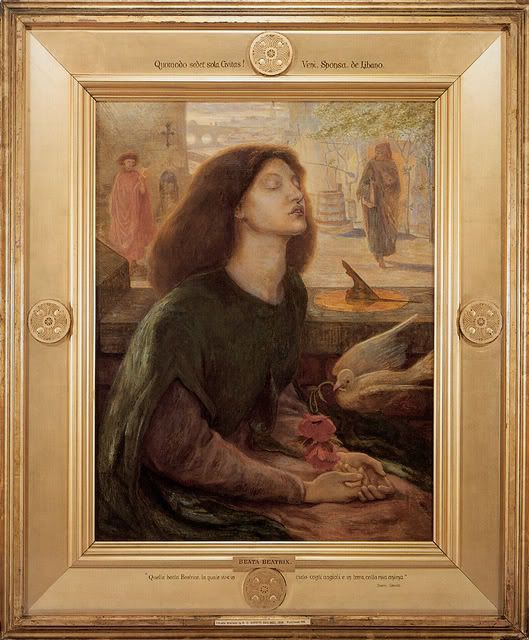
“Apostles of Beauty: Arts and Crafts from Britain to Chicago” is a new exhibit at the Art Institute of Chicago celebrating the Arts and Crafts movement. For those of you who would love to see Dante Gabriel Rossetti's "Beata Beatrix" in the flesh, this is your chance, as it's one of the pieces featured in the exhibit!
"Apostles of Beauty" features 187 "handcrafted, organic works by the movement's most notable practitioners." The pieces in the show are drawn from a variety of artistic disciplines, including ceramics, wood and metalwork, paintings, photographs and textiles.
In its overview of the exhibit, the museum's website calls the Arts and Crafts movement "one of the most politically progressive and aesthetically compelling artistic movements of modern times." It planted the seeds for the sort of critical thinking about modern living that has driven the green movement. Arts and Crafts connected organic thinking and living on a large scale for the first time, and demonstrated that the "beautiful and useful" as William Morris loved to say, were not mutually exclusive. As the museum's website so beautifully puts it:
The Arts and Crafts movement sprang from a rebellion against industrial life and mass-produced objects yet eventually united hand and machine in the service of beauty.
On a side note, it certainly seems like 2009 has been a great year for interest in Arts and Crafts and the Pre-Raphaelites. It would be interesting to know if there are actually more exhibits being held, or if it just seems like there are because I'm always looking for them! (I suppose I could find out if I had the time or discipline to research the issue). Could it be a bit of both?
"Apostles of Beauty" runs now through January 31, 2010.
Read more at The Art Instutute of Chicago's website.
Posted by
Margaret
at
1:53 PM
2
comments
![]()
![]()
Labels: art nouveau, arts and crafts, museums, news, rossetti, william morris
Saturday, December 5, 2009
'Desperate Romantics' Makes Telegraph's List of Art History Books of the Year
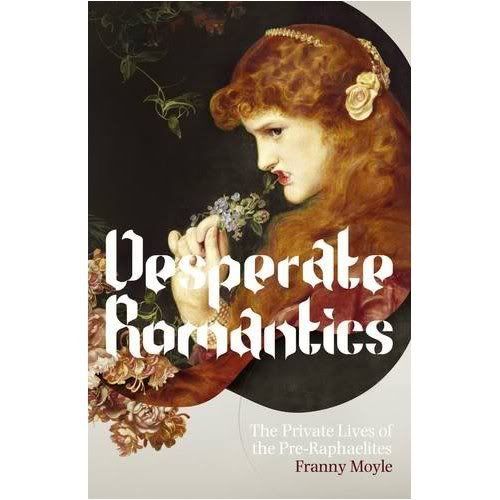
It's been a great year for the Pre-Raphaelites! Franny Moyle's book, "Desperate Romantics", which inspired the television series of the same name, was named in the UK Telegraph's list of Art History Books of the Year.
There are a number of books on the list that will be of interest to Art History lovers. For the full list, click here.
Posted by
Margaret
at
2:51 PM
1 comments
![]()
![]()
Labels: books, news, pre-raphaelites
Friday, November 27, 2009
Imperishable Beauty at the Cincinnati Art Museum
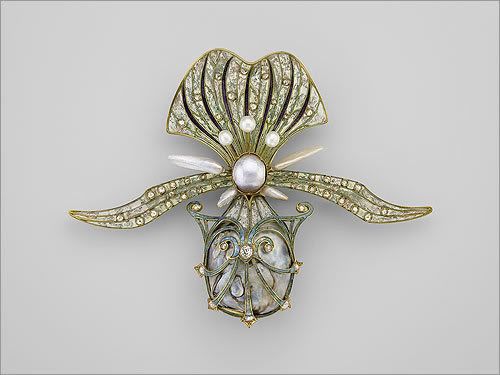
For those of you in the Ohio area, there's a new exhibit of Arts Nouveau Jewellery at the Cincinnati Art Museum. Entitled "Imperishable Beauty," the exhibit opened November 17, 2009, and features jewellery designed by René Lalique, Henri Vever, Philippe Wolfers and Tiffany & Co. In addition, textiles by William Morris, posters by Alphonse Mucha, Tiffany glass, silver, and ceramics from the Cincinnati Art Museum’s permanent collection will also be featured in order to give a background for the art movements that influenced these designers. 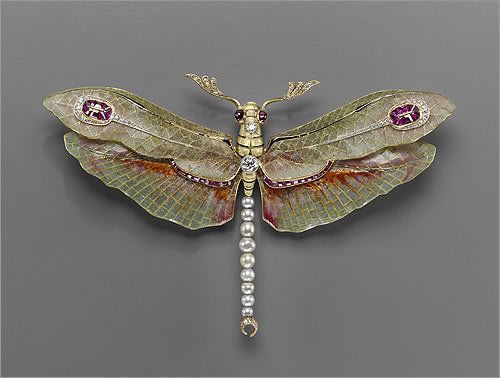 One of the staggering aspects of Art Nouveau jewellery is the realism and detail that the best designers were able to bring to their work. This dragonfly brooch by Belgian artist Philippe Wolfers (Belgian, 1858–1929) is constructed from platinum, gold, enamel, diamond, ruby, and pearl, but it looks so life-like. Beautiful, useful, and true to nature - definitely wearable art!
One of the staggering aspects of Art Nouveau jewellery is the realism and detail that the best designers were able to bring to their work. This dragonfly brooch by Belgian artist Philippe Wolfers (Belgian, 1858–1929) is constructed from platinum, gold, enamel, diamond, ruby, and pearl, but it looks so life-like. Beautiful, useful, and true to nature - definitely wearable art!
The exhibition will run from now until January 17, 2010. For more information, visit the Cincinnati Art Museum website. There are a number of related programmes and events that sound like a lot of fun!
Images courtesy Museum of Fine Arts, Boston. Top image: Orchid brooch, 1901. Georges Fouquet (French, 1862–1957). Gold, enamel, diamond, and pearl.
Posted by
Margaret
at
2:36 PM
5
comments
![]()
![]()
Labels: art nouveau, arts and crafts, museums, news, william morris
Thursday, November 19, 2009
Pre-Raphaelite Christmas Stamps Released by Royal Mail

The Royal Mail has released a lovely set of Pre-Raphaelite stamps in time for the holiday season. The collection was chosen by designer Andrew Ross, who examined stained glass from churches throughout England in order to compile the artwork for the set of stamps. The final designs were taken from churches in Cumbria, Norfolk, Somerset, East Sussex and Wiltshire.The angel with the mandolin (middle) was designed by William Morris, while the Wise Man stamp (bottom middle) is from some stained glass by Edward Burne-Jones. The art for the 1st, 56p and £1.35 stamps are from stained glass created by Henry Holiday, who worked with Edward Burne-Jones in his studios.
"We are extremely privileged to have access to such a rich history of beautiful stained glass designs in churches and other buildings around the UK," said Julietta Edgar, Head of Special Stamps, Royal Mail.
"These precious images of the nativity have a timeless appeal and are a wonderful way of telling the story of Christmas here and around the world."
It appears that the stamps already have a following - Wales online reports that a number of the Pre Raphaelite stamps were stolen before they were made available to the general public. As a result, "ANYONE offered Royal Mail’s newest commemorative Christmas stamps on the cheap is being asked to contact police after a new delivery was stolen in a burglary." The thieves weren't just desperate romantics, though - they also stole cash, phone cards and cigarettes.
Posted by
Margaret
at
1:52 PM
9
comments
![]()
![]()
Labels: edward burne-jones, pre-raphaelites, william morris
Thursday, November 12, 2009
William Morris Fan Club

Thank you so much for all of your comments on my previous post! I have been rather occupied with my baby girl this week, but I did find the time to discover a new site that I think will be of interest to readers of this blog. William Morris Fan Club is a blog devoted to William Morris' design and the Arts and Crafts Movement in general. Check it out!
Posted by
Margaret
at
11:36 AM
3
comments
![]()
![]()
Labels: blogging, william morris
Thursday, November 5, 2009
A New Arrival

As some of you guessed from my last post, our lovely little girl arrived last Wednesday evening. She is an absolute treasure, as you can see!
Posted by
Margaret
at
7:38 AM
22
comments
![]()
![]()
Labels: news
Thursday, October 29, 2009
Van Gogh on Babies
If one feels the need of something grand, something infinite, something that makes one feel aware of God, one need not go far to find it. I think that I see something deeper, more infinite, more eternal than the ocean in the expression of the eyes of a little baby when it wakes in the morning and coos or laughs because it sees the sun shining on its cradle. If there is a "ray from on high," perhaps one can find it there. (Letter 242)
Vincent Van Gogh
Posted by
Margaret
at
7:38 AM
7
comments
![]()
![]()
Thursday, October 22, 2009
John Knight's Pre-Raphaelite Photography
Photographer John Knight has a passion for the Pre-Raphaelites (and for vintage and fine art photography in general). Knight's specialty is the Art Deco period (his studio is actually called Art Deco Studio), but he began his work recreating Pre-Raphaelite images after using two models he felt strongly resembled Jane Morris and Lizzie Siddal. Since then, Knight has recreated a number of iconic Pre-Raphaelite images for modern audiences. 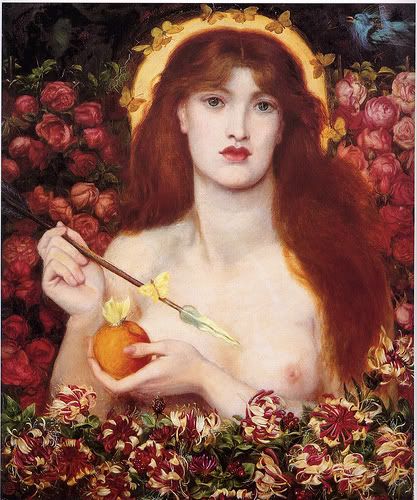
And here we have John Knight's photographic interpretation of the painting: 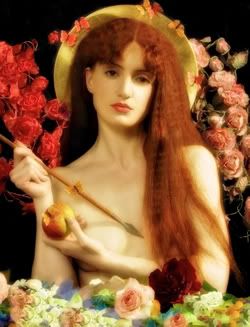
Of course, Knight uses a great deal of image editing software in order to reproduce the paintings, but it would be impossible to make them look much like the originals without it.
His interpretation of Frederick Sandy's "Love's Shadow" is spectacular, though it shies away from the energy and anger of the original. The girl in Knight's version is a quite a bit more coy and far less threatening than Sandys' (who you will recall is actually baring her teeth in the painting).
Knight's version: 
Anthony Frederick Sandys' version - teeth bared, and looking a bit vicious: 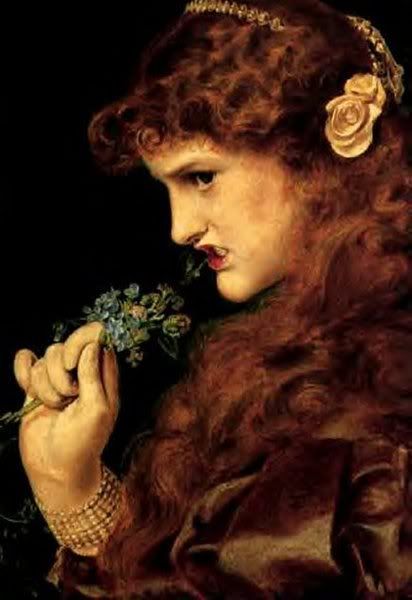
I asked Knight what drew him to Pre-Raphaelite art. He replied that
"the images created by the PRB are amongst the most enduring of all art works ever created. They touch the soul and the heart, they challenge the eye and they transport the viewer back...back to fantasy, to chivalry, to folklore and myth to the stories of our childhood and the dreams of our imagination."
I couldn't agree more!
Be sure to check out John Knight's website for more of his Pre-Raphaelite images. Many are quite extraordinary--I think my favourites are the Venus Verticordia (shown above) and Flaming June.
Posted by
Margaret
at
10:11 AM
6
comments
![]()
![]()
Labels: frederick sandys, photography, pre-raphaelites, rossetti
Thursday, October 15, 2009
Leonardo da Vinci's Fingerprint Discovered on Painting
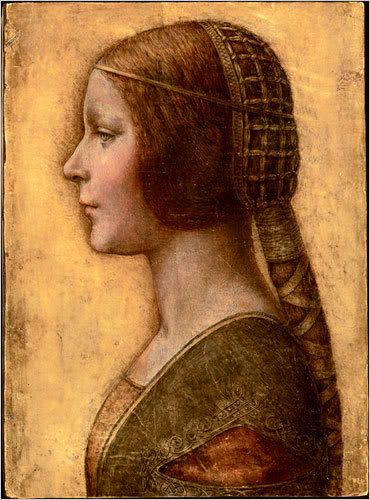
Last year I did a post about a debate raging over whether or not the painting The Marriage Portrait of a Young Woman (pictured above) was an original Leonardo da Vinci.
One year later and the controversy is far from over. The battle is still raging among art experts over whether or not the painting is actually by da Vinci.
Most recently, a lab in Paris has discovered a fingerprint in the upper left hand corner that appears to belong to Leonardo da Vinci(it kind of surprises me that they are not able to tell definitively if the fingerprint matches - especially with all that pricey forensic equipment). Originally, Christie's auction house had valued the painting at under $20,000.00, but of course that was before the painting had been subjected to more detailed investigation.
Further investigation into the painting are ongoing, but this must be great news for Canadian art collector Peter Silverman. Silverman purchased the work for around $21,850 in 2007. If the painting does turn out to be a da Vinci, it will most likely be worth tens of millions of dollars. Not a bad investment!
The BBC has a video of the latest news about the painting, which can be viewed on the BBC News website.
Posted by
Margaret
at
9:41 AM
7
comments
![]()
![]()
Labels: news
Thursday, October 8, 2009
Memphis Brooks Museum Hosts "Masterpieces from Museo de Arte de Ponce"

Now through January 10, 2010, the Memphis Brooks Museum will be hosting an exhibit of 56 paintings entitled "Masterpieces from Museo de Arte de Ponce."
The Museo de Arte de Ponce is well-known for it's spectacular Pre-Raphaelite collection, which will be featured prominently in this exhibition. However, the show will also feature paintings from a number of different periods, and includes works from Baroque artist Peter Paul Rubens and the Belle Époque master James Tissot
The Brooks Museum has a couple of events on October 15, 2009 to celebrate the collection, including a "Tea and Tour" from 1:30 - 3 pm. Enjoy tea and treats after a special tour with the docents ($3 per person). The event is sponsored by the Brooks Museum League. Reservations are required, please call 901.544.6242. A dinner will also be held the same night--call the number above for more information.
For more information, check out the Brooks Museum Website
Posted by
Margaret
at
11:49 AM
3
comments
![]()
![]()
Labels: museums, news, pre-raphaelites
Thursday, October 1, 2009
Victoria and Albert Museum's William Morris Print Book
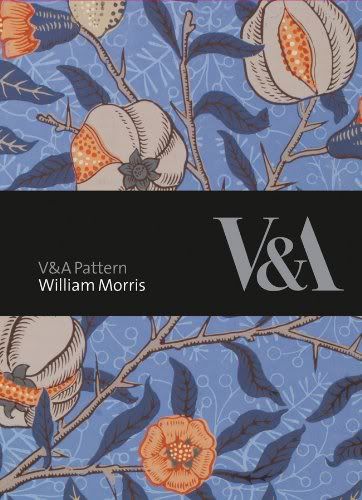
The Victoria and Albert Museum has announced publication of a new William Morris Pattern Book. The book will come with a CD of the pattern images, so that designers can be free to research and modify the designs as they choose.
The collection was put together by Linda Parry, whom many William Morris buffs will immediately recognize as the author of some of the best books on Morris' design work. Parry served as curator of the V&A's 1995 William Morris exhibit, and is one of the world's foremost experts on Morris. Parry also worked as deputy keeper of the Furniture, Textiles and Fashion Department at the V&A for many years.
I just ordered my copy and I can't wait for it to arrive! I'm really curious to see what I can do with the CD--I'm thinking it will be perfect for adapting some of the designs to needlework, etc.
This title is available through The Earthly Paradise Bookstore.
Posted by
Margaret
at
8:55 AM
8
comments
![]()
![]()
Labels: arts and crafts, books, news, william morris
Wednesday, September 23, 2009
J.W. Waterhouse Garden of Enchantment
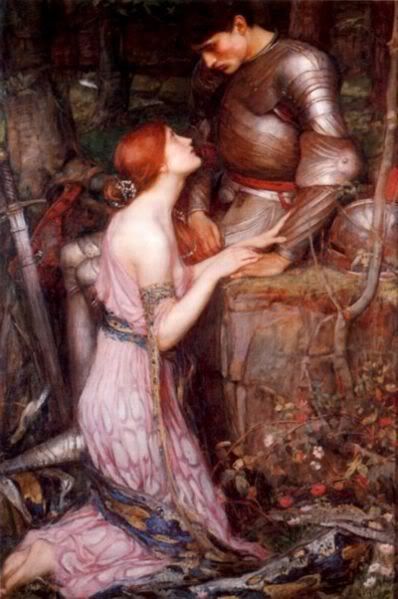
A new exhibit of J.W. Waterhouse's work will be held at the Montreal Museum of Fine Arts from October 1, 2009, to February 7, 2010. The exhibit will feature the largest-ever retrospective of works by John William Waterhouse (1849-1917). J. W. Waterhouse: Garden of Enchantment will be the first large-scale exhibition of Waterhouse’s work since 1978, and promises to be the first expo to focus on works from throughout his lengthy artistic career.
The Montreal Museum of Fine Arts will have at least eighty works of art, on loan from public and private collections throughout the world. Garden of Enchantment will also feature a number of Waterhouse's sketches in oil, chalk and pencil (many of these works have not been seen in public since Waterhouse's death). The exhibition has been organized by the Groninger Museum, the Netherlands, with the collaboration of the Royal Academy of Arts, London, and the Montreal Museum of Fine Arts. The exhibition, which premiered at the Groninger Museum, will also be presented at the Royal Academy of Arts (June 27 to September 13, 2009), and the Montreal Museum of Fine Arts (October 1, 2009, to February 7, 2010).
It sounds like Garden of Enchantment will be a fabulous exhibit. I would desperately love to get a chance to see these works in person!
For more information, visit The Montreal Museum of Fine Arts website
Posted by
Margaret
at
8:04 AM
7
comments
![]()
![]()
Labels: museums, news, pre-raphaelites, waterhouse
Tuesday, September 15, 2009
"The Earthly Paradise" Edward Burne-Jones Exhibit at Staatsgalerie in Stuttgart
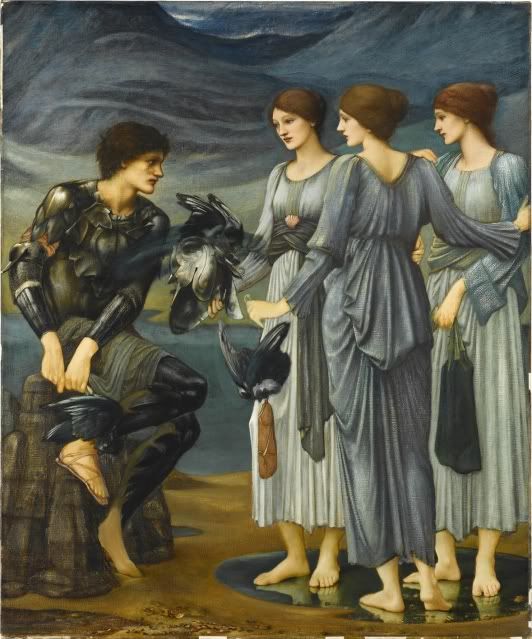
"The Earthly Paradise," a new exhibit of Sir Edward Burne-Jones' work, will be showing at the Staatsgalerie in Stuttgart, Germany, beginning October 24, 2009 and running through February 7, 2010. The exhibit will focus on Burne-Jones spectacular narrative paintings.
Burne-Jones' paintings often retell classic tales from literature and mythology, and this exhibit will pay particular attention to his well-loved Perseus (which is part of the Staatsgalerie's permanent collection) and Briar Rose cycles. The tapestries he created with scenes from King Arthur and his Knights will also be featured.
The exhibit draws its title,"The Earthly Paradise," from William Morris' book of poems by the same name. First published in 1868, The Earthly Paradise helped to inspire Burne-Jones to create his narrative paintings. And I'm so glad it did! Sir Edward Burne-Jones created so many beautiful paintings that tell fantastic stories from an ideal age. You can look at them for ages and never cease to be transported.
"The Earthly Paradise" promises to be a multimedia exhibit, and Burne-Jones paintings will be shown alongside stained-glass windows, book illustrations, furniture and other arts and crafts era items. It's a chance to experience "a living environment shaped by art." I'm sure nothing would have pleased Burne-Jones more.
If you plan on being anywhere near Stuttgart between October and February, "The Earthly Paradise" is a must-see. It's definitely a once in a lifetime chance to see these beautiful paintings side by side.
For more information, check out the Staatsgalarie's official Burne-Jones website . The site can be accessed in English here.
Curatorial supervision of "The Earthly Paradise" ("Das Irdische Paradies") by Dr. Christofer Conrad, with assistance by Dr. des. Annabel Zettel. The exhibit is under the patronage of the British Ambassador to Germany, Sir Michael Arthur.
Edward Burne-Jones, Perseus and the Sea-Nymphs, 1877-1898, oil on canvas. Image courtesy Staatsgalerie Stuttgart.
My heartfelt thanks goes to the Staatsgalerie for bringing this exhibition to my attention.
Posted by
Margaret
at
7:03 AM
9
comments
![]()
![]()
Labels: edward burne-jones, museums, news, pre-raphaelites
Tuesday, September 8, 2009
Liberty London Shows Flair for Fashion
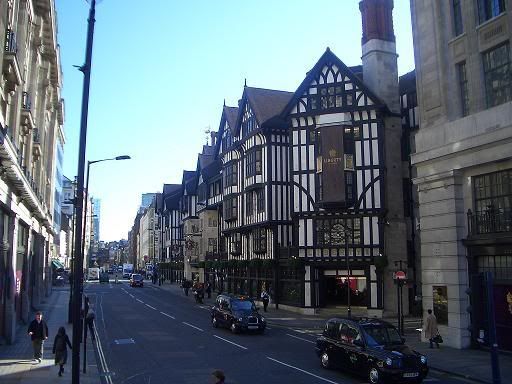
Liberty & Co. has long been associated with the Arts and Crafts movement. William Morris' prints have become almost synonymous with the famous London shop, and Oscar Wilde once commented that Liberty was the “the chosen resort of the artistic shopper.”
The recent economic downturn has been difficult for the London store, and Liberty is responding to market pressures by cultivating a slightly more modern design aesthetic. Liberty's CEO, Geoffroy de La Bourdonnaye, is injecting some high fashion flavour into the store through a relationship between Liberty and Hermès.
The iconic french fashion house will be opening a "pop up" boutique in the centre of the store that will feature Hermès scarves and neckties.
The theme of "romance and rebellion" will be continuing with a series of ready to wear prints created exclusively for Liberty by Rolling Stones rocker Ronnie Wood. Wood, who was last featured on this blog when his daughter married in a Pre-Raphaelite inspired gown, has become respected as an artist in his own right. I particularly enjoyed the print he created for the dress below: 
I love Hermès (who doesn't?), and Ronnie Wood's prints do seem like a lot of fun. At the same time, I hope Liberty doesn't lose sight of their fabulous Arts and Crafts heritage in an attempt to remain hip.
Read more at the New York Times
Posted by
Margaret
at
9:06 PM
6
comments
![]()
![]()
Labels: arts and crafts, news, reviews, william morris
Wednesday, September 2, 2009
The Sting of Passion - Manchester Art Gallery

From now until October 25, 2009, Manchester Art Gallery will be hosting an exhibit of Pre-Raphaelite-inspired jewellery from twelve international designers. The jewellery will be shown alongside paintings from the museum's extensive Pre-Raphaelite art collection that have inspired the artists.
Admission to the show is free, so if you're nearby, this is something to be sure to check out!
Image courtesy Manchester Art Gallery. Jivan Astfalck Bracelet: Sting of Passion 2009 Sterling silver, fine gold and garnets.
Posted by
Margaret
at
7:42 AM
5
comments
![]()
![]()
Labels: museums, news, pre-raphaelites
Tuesday, August 25, 2009
Victorian Art on Display at Brigham Young University Museum of Art
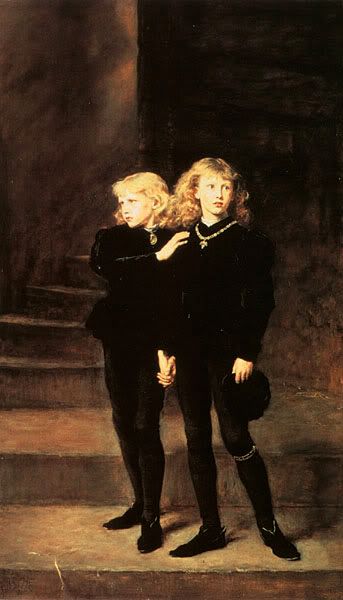
Brigham Young University Museum of Art is currently hosting an exhibit of Victorian-era artworks from the Royal Holloway collection entitled Paintings from the Reign of Victoria: The Royal Holloway Collection, London . Pre-Raphaelite John Everett Millais' 1878 painting The Two Princes Edward and Richard in the Tower, 1483 (shown above) is among the works on display.
The exhibition will run from August 14-October 24, 2009, and is a must see for anyone in the area. Admission to the exhibit is free of charge. You can even organize a free docent-led tour of the exhibit by calling the Museum Education Department at 801-422-1140. You can also check out Brigham Young University Museum of Art's sepcial Royal Holloway exhibit website for more background information on the event. (It's a great resource, especially if you aren't able to make it to the exhibit).
image courtesy Wikimedia commons.
Posted by
Margaret
at
8:34 AM
4
comments
![]()
![]()
Tuesday, August 18, 2009
William Morris and Islamic Art
Journalist Navid Akhtar has taken an opportunity to examine the influence that Islamic design had on William Morris.
Akhtar argues that Morris' designs are "inextricably linked to the curving sinuous arabesques of traditional Islamic Art," pointing out the strong connection between Morris' work and Turkish ceramics and Persian carpets.
Akhtar goes on to argue that Morris was influenced, not only by the aesthetics of Islamic art, but by the principles that guided that art. He even suggests that Morris' famous decorating maxim "have nothing in your house that you do not know to be useful, or believe to be beautiful,"--is drawn from a saying in the Koran that "God is beautiful and loves beauty".
While this might be a bit of a stretch, it's undeniable that Morris and many of his friends in the Pre-Raphaelite Brotherhood were strongly influenced by Islamic design elements (particularly the repetition and symmetry that can be found in many middle-eastern art). Akhter suggests that many of the notions that Morris held dear--such as the importance of social consciousness, usefulness and beauty in every day objects-- were also common to Islamic art.
I think it was very important to Morris that these ideals were universal, but it's also interesting to see that a new generation of Muslim artists using Morris as artistic inspiration. What are your thoughts?
You can listen to the full radio broadcast at the BBC.
Posted by
Margaret
at
8:49 AM
8
comments
![]()
![]()
Labels: architecture, arts and crafts, news, reviews, william morris
Monday, August 10, 2009
BBC 4 The Pre Raphaelites
For those of you living in the UK, the BBC has released a 3-part documentary series on the Pre-Raphaelites to coincide with Desperate Romantics. Since Desperate Romantics is rather short on historical context, be sure to watch the documentary alongside the costume drama, especially if this is your first introduction to the Pre-Raphaelites. 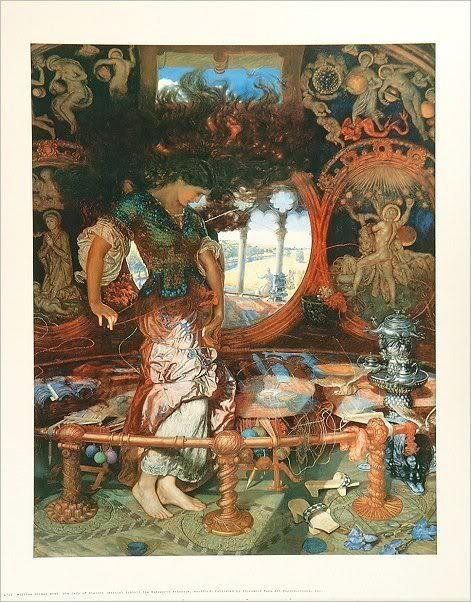
The documentary, entitled The Pre-Raphaelites: Victorian Revolutionaries, features author Jan Marsh (author of Pre-Raphaelite Sisterhood) and a number of other art historians discussing the PRB's rise to fame, their landscape art and the eventual commercialisation of their work.
I really enjoyed the series, although I found it a little annoying that they kept insisting that the Pre Raphaelite Brotherhood somehow "sold out" when they began to find a market for their art. The series really pushes the notion that the Pre-Raphaelites were somehow the first artists to commercialise their work (and that this was a betrayal of their earlier, nobler ideals). Artists and writers have always wanted to profit from their work. It's pure romantic fantasy to imagine that there was some golden age of art where everyone indulged in art for art's sake without an eye toward profits. The PRB simply lucked out by being in the right place at the right time, and they took advantage of the technology that was available to them. I'm quite sure that if Sir Joshua Reynolds had lived through the Victorian era, he too would have been hawking his lithographs right alongside the former members of the PRB. You will remember that even the socialist William Morris was a businessman! It seems very hard for the BBC to conceive of the possibility that one might simultaneously be a romantic revolutionary and hope to pay the rent.
For those of you living in the UK, several of the episodes are available in streaming video online through the BBC Pre-Raphaelites mini site.
Episode 2, which covers the Pre-Raphaelites approach to landscape art, will be aired again on August 11 at 10:00 pm.
Posted by
Margaret
at
8:24 AM
7
comments
![]()
![]()
Labels: millais, news, pre-raphaelites, reviews, rossetti, william holman hunt, william morris
Monday, August 3, 2009
Desperate Romantics - First Impressions
I finally had a chance to watch the first two episodes of BBC's Desperate Romantics with Javier last week. We both really enjoyed it. Overall, I found it highly entertaining (and yes, it was quite accurately described by its producer as "Entourage with easels"). The production was a bit weak on the historical front, but I suppose this was done by the writers to broaden the appeal of the series.
The series focuses on the early years of the Pre-Raphaelite Brotherhood and follows their rise to fame.
I was pleasantly surprised with the casting, particularly that of Lizzie Siddal. The actress who plays Lizzie not only resembles Siddal a great deal, but she also does an excellent job of bringing life and pathos to the character. John and Effie Ruskin are also well-cast, and are more developed than I had anticipated, although the endless speculation about what was wrong with their marriage always gets to me--honestly, nobody has any idea what the problem was (biographers seem to constantly return to the idea that Ruskin was disgusted by Effie's body hair, but how could they know?). Nevertheless, much like the rumours about Michael Jackson, I suppose this gossip is just too juicy for scriptwriters to pass up.
Unfortunately, the characterization of most of the other major players is rather simplistic, though it is in keeping with the rest of the shows' approach. Aidan Turner is handsome and energetic as Dante Gabriel Rossetti, if a bit one-dimensional. William Holman Hunt's character certainly seems to have drawn the short straw in terms of personality. Most biographers of the Pre-Raphaelites tend to consider Hunt a bit of a blowhard, but he's painted with such a broad brush in this production that it borders on the ridiculous. I hope that the writers will add some nuance to his character in the remaining episodes. Perhaps the most promising character so far is that of John Everett Millais, who is played by Samuel Barnett. Millais' character is quite endearing, and it looks like we will be seeing more of him in tonight's episode.
The character I could sort of do without is Fred Walters--a fictional hanger-on that is meant to function as a bit of a window into the lives of the PRB. He's sort of an amalgamation of a number of real-life members of the brotherhood, but I really wish that they had included William Michael Rossetti in the story instead. William Michael has always seemed quite interesting to me, and he certainly did a great deal to contribute to the visibility of the Brotherhood. I suppose the writers felt that adding in another member of the Rossetti family would rob Dante Gabriel of some of his mystique, but I digress.
Overall, I'm definitely enjoying the series. It's so nice to finally see the lives of the Pre-Raphaelites dramatized! Desperate Romantics may fall a bit short on historical accuracy, but the story of the Pre-Raphaelite Brotherhood is so inherently exciting that the show can't help but be enormously entertaining.
I'd be extremely interested to hear from others who've had a chance to see the first few episodes. What were your first impressions? Were you pleased or disappointed? Do you think the show will revive interest in the Pre-Raphaelites?
Posted by
Margaret
at
11:31 AM
11
comments
![]()
![]()
Labels: millais, news, pre-raphaelites, reviews, rossetti, ruskin, william holman hunt
Sunday, July 26, 2009
Joke Written by George Bernard Shaw about William Morris Unearthed after 79 Years
BBC News reported yesterday that a researcher has discovered a joke written by playwright George Bernard Shaw in honour of the opening in 1930 of the Hall at William Morris House in Wimbledon. The joke was found written in Shaw's hand on a photograph of himself, and reads as follows:
"William Morris and I preached the gospel of Labour together on many occasions.
"Many respectable persons thought we deserved hanging. I am proud to hang in a hall dedicated to him."
The note was discovered by researcher Peter Walker in a cupboard among the archives of the Wimbledon Labour Party. Walker noted that, "[t]he discovery of this original picture and handwritten joke by one of our greatest playwrights is very exciting."
It's interesting to see that Shaw seems to have had fond memories of Morris. I always knew that they shared similar political views, but they seem to have had a long history together. Both men started as members of the Social Democratic Foundation (SDF), and they actually started the Socialist League together in 1885, together with Eleanor Marx. Small world!
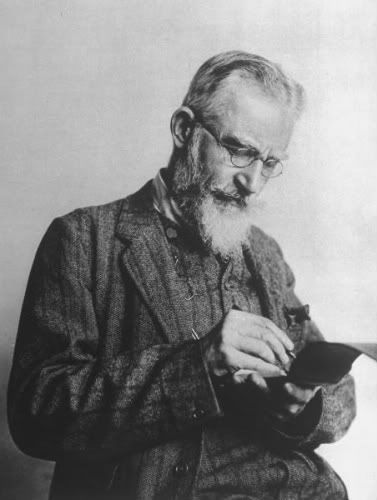
Posted by
Margaret
at
10:36 PM
4
comments
![]()
![]()
Labels: arts and crafts, news, william morris
Monday, July 20, 2009
Prince Charles Declines to Renew his Patronage of the Society for the Protection of Ancient Buildings

His Royal Highness, Prince Charles, who has been patron of the Society for the Protection of Ancient Buildings (SPAB) since the death of the Queen Mother, has withdrawn his support after a difference of opinion with the members of the society's board. The Prince failed to renew his patronage of the society when it came up for renewal last year.
The Prince apparently raised the ire of the society by contradicting their stated views on restoration in a forward he wrote for a book on architecture. In the forward, the Prince argued that historical buildings should always be restored in their original style.
I can't help but feel that William Morris, who founded the society back in 1877, would have agreed wholeheartedly with the Prince on this particular matter. Morris was very much against reproduction of historical buildings, but was a strong supporter of historical preservation and protection. One only has to look at the "new designs" that Morris appreciated in order to realise that he was not quite as supportive of all forms of architectural innovation as the SPAB would have us believe. Morris found most modern design downright ugly, and I'm sure that he and the Prince would have agreed on that point.
While the SPAB's mandate might warn against "feeble and lifeless forgeries," it hardly seems fair that this should remain the chief concern for historical preservationists in this day and age, when we have much better access to appropriate materials for restoration. The danger of damaging the integrity of the historical architecture is far greater. However, it appears that the board of the society disagrees. They apparently requested that the Prince amend the forward to the book to more closely align with their own views and he refused.
It's surprising that the Society for the Protection of Ancient Buildings would actually refuse royal patronage from someone who happens to share views so similar to those of the society's founder. William Morris always felt it was disingenuous to try to imitate historical architecture, but he remained strongly convinced about the importance of preserving buildings as carefully as possible. I haven't seen the Prince's forward (and it sounds like none of us ever will), but it would be interesting to know what the fuss was all about. Besides, it seems that if Morris had seen some of the more atrocious examples of modern restoration, he might have agreed with the Prince even more! I guess I'm a bit of a Luddite, but I would prefer to err more on the side of cautious restoration than of reconstruction using new styles.
The SPAB has yet to name a new patron.
For more info on this story, see the Independent
The press release from the SPAB can be found on the Society's website
Image courtesy of Wikimedia commons.
Posted by
Margaret
at
7:37 AM
8
comments
![]()
![]()
Labels: architecture, news, william morris
Monday, July 13, 2009
Julia Margaret Cameron Exhibit
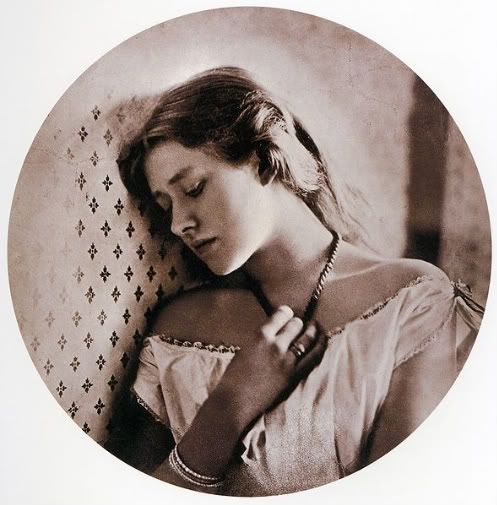
A new exhibit of Julia Margaret Cameron's photography is currently underway at the Portland Museum of Art in Portland, Maine. The exhibit began July 4 and will run through till September 7, 2009.
The exhibition is entitled "For My Best Beloved Sister Mia: An Album of Photographs by Julia Margaret Cameron." The works included in the showing were put together for Julia Margaret Cameron's sister, Maria Jackson (known as Mia). Cameron originally gave her sister the partially filled album as a gift on July 7, 1863, at the beginning of Julia Margaret Cameron's experiments with photography. Over the years, Mia filled the album with many of her sister's most iconic images.
Cameron's portraits are well known for their romantic quality and for their close association with the Pre-Raphaelite movement. Many of the most well-known photographs of a number of Victorian celebrities, such as Charles Darwin and Alfred Lord Tennyson, were also taken by Cameron.
For more information, visit the Portland Museum of Art's website.
For those of you who are aren't able to make it to this showing, the next engagement of this travelling exhibit will be from October 23, 2010 - January 2, 2011
at the Frick art & historical center in Pittsburgh, Pennsylvania.
Ellen Terry by Julia Margaret Cameron, 1864. Image courtesy wikimedia
Posted by
Margaret
at
8:04 AM
8
comments
![]()
![]()
Labels: julia margaret cameron, museums, news, pre-raphaelites
Monday, July 6, 2009
The Pre-Raphaelites Brought to Life at Preraphaelites.org
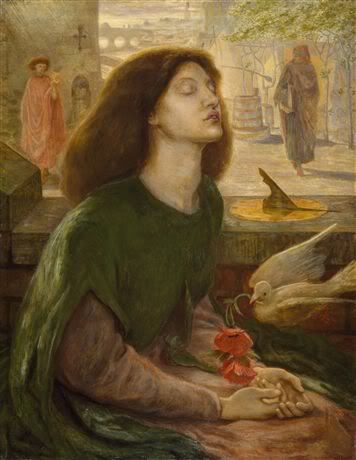
The Birmingham Museum of Art (which houses the largest public collection of Pre-Raphaelite Art) has just unveiled their new website, Preraphaelites.org, which promises to offer the most intimate experience of the Pre-Raphaelites work that can be achieved outside of visiting the museum.
The website uses Microsoft’s Silverlight technology, which allows the viewer to expand the artworks as much as possible while maintaining the integrity of the image. It is a spectacular tool, and I can't wait to see more museums adopt this method of cataloguing the works in their collections.
I used Silverlight to take a closer look at Dante Gabriel Rossetti's Beata Beatrix, and I have to admit it was an extraordinary experience. The detail is incredible! I have only had the opportunity to view a few Pre-Raphaelite artworks in person, and this technology does allow you to get much closer to the work than they would ever let you get in person. (Even more than in France, where they are extremely permissive of museum guests getting quite close to the paintings!).
In addition to allowing you to see the finest details of many of the works in their collection, the website also points you to related works. In the case of Beata Beatrix, this leads you to a number of sketches of the work. They also seem to offer more detailsa about the works than other museum websites do, and if you register for the website, you can even discuss the paintings with other art fans online.
I originally heard about this project thanks to an email from the Communications Officer for Environment & Culture at the Birmingham City Council. I am so glad they emailed me and that the Council is getting the word out about this great resource! I can see why the Birmingham City Council is quite proud of this site. It really offers a unique opportunity for art lovers across the globe to see these works "up close and personal" and I think the site will generate a lot of tourism once people see what the museum has to offer.
Of course, nothing can replace the experience of seeing these works in person, but this new website does get awfully close. And for those of you planning to visit Birmingham Museum and Art Gallery, I strongly urge you to visit this website first. If there are any artworks you are hoping to see in person, you can actually request a viewing through the website! This is an amazing service. I'm used to having to write to museums, but this tool makes the entire process so much easier (plus it makes it seem like they actually want to let you see the works!). This is especially important to do if there are any lesser-known sketches that you would like to see in person, as these might be in storage at the time of your visit. Again, I can't possible stress enough what a great resource this is!
Kudos to the Birmingham Museum and Art Gallery for these great tools. It's so great to see museums putting their catalogue online and taking advantage of new technology that compliments, rather than detracts from, the artwork. I am a firm believer that giving public access to artwork generates a tremendous amount of interest. I hope this great site makes a new generation fall in love with the work of the Pre-Raphaelites.
Image courtesy Birmingham Museum of Art.
Posted by
Margaret
at
8:34 AM
9
comments
![]()
![]()
Labels: museums, pre-raphaelites, reviews, rossetti, technology
Monday, June 29, 2009
Desperate Romantics
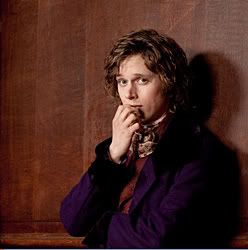
At long last, some additional news has broken about the BBC television adaptation of Franny Moyle's Pre-Raphaelite potboiler, Desperate Romantics. After months with no news, cyberspace finally has a fresh injection of stories about the much-anticipated series.
One of the more interesting articles I came across was Rapid Talent's interview with Samuel Barnett, who will be playing John Everett Millais. Barnett describes getting acquainted with his character through field trips to the National Gallery:
"I like all sorts of art, that's why I love wandering around The National Gallery. I really admire paintings that look like an actual snapshot – I think that's just extraordinary. That's what's so special about Millais: flesh – people's actual skin – looks real, for example in The Order Of Release and Christ In The House Of His Parents; it's photographic, it doesn't matter how close you get to the painting, you don't see the brushwork. With Millais's paintings it's microscopic; when he does hair it's extraordinary, you can see every strand. His paintings are my favourites – not just because I'm playing him – I think he's the best artist of the group, technically and also emotionally."
I would have to agree, though, as you all know, I have a great appreciation for Burne-Jones and Rossetti as well.
Although I'm a little disappointed that the BBC feels it's necessary to portray the Pre-Raphaelites as prototypes for modern models and rock stars, I suppose it makes it makes sense from a marketing perspective. And, in all honesty, I must admit that I was always drawn to that aspect of their story. As Barnett points out, the Pre-Raphaelites came on the scene just as the public was gaining greater access print publications than ever before:
"You don't have to know anything about the period or the artists; it's a human story and a 'sex, drugs and rock 'n' roll' story as well: this was the period when supermodels and celebrity was born. The use of the printing press meant everyone, nationally and internationally, could see these guys' paintings and the models they used, that was a first – art had never had exposure like that before."
You can read the full story at Rapid Talent UK.
Also, special thanks to Grace at The Beautiful Necessity for bringing to my attention the fact that news stories about Desperate Romantics are finally starting to get out!
Posted by
Margaret
at
8:17 AM
7
comments
![]()
![]()
Labels: edward burne-jones, millais, news, pre-raphaelites, rossetti, ruskin
Thursday, June 25, 2009
Pre-Raphaelite Art at the Delaware Art Museum
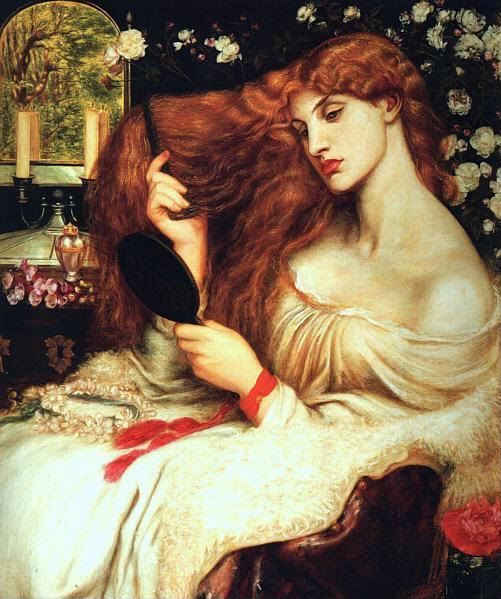
I'm always on the lookout for great Pre-Raphaelite art online, and yesterday I came across the Delaware Art Museum's fabulous Pre-Raphaelite art gallery, which features the collection of Samuel and Mary Bancroft. The Delaware Art Museum has the largest permanent collection of Pre-Raphaelite works in the United States. The museum maintains their collection through the generous support of the aptly-named "Rossetti Circle" of art patrons. I would definitely join if I lived anywhere near Delaware! Anyway, it's a lovely, well put together website with an extensive collection of photos of Pre-Raphaelite art and art objects. I highly recommend taking a moment to enjoy what they have to offer.
I was particularly impressed by the Delaware Art Museum's education packet on the art of the Pre-Raphaelites. It's available for download here. This curriculum package covers the Pre-Raphaelites, William Morris and the Arts and Crafts Movement, The Aesthetic Movement--and pretty much everything else that is important to the study of Pre-Raphaelite Art. It's one of the best resources of it's kind that I have come across, and far superior to many books that I've read on the subject! If you are looking for some more information on the topic of the Pre-Raphaelites, it's definitely a great place to start.
Posted by
Margaret
at
8:22 AM
8
comments
![]()
![]()
Labels: arts and crafts, museums, pre-raphaelites, reviews, rossetti, william morris
Monday, June 22, 2009
Forbes Family to Sell Pre-Raphaelite Masterpieces
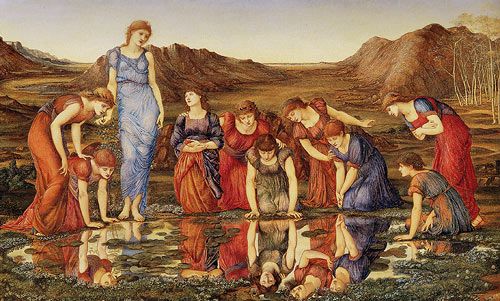
If the Forbes family is reduced to selling off their priceles Pre-Raphaelite treasures, what does that mean for the rest of us?
The family is in the process of selling a trove of art treasures from their London home for an estimated £5million. The collection included several pieces by prominent Pre-Raphaelites Sir Edward Burne Jones and Sir John Everett Millais. Two of Millais' paintings, 'For The Squire' and 'Trust Me,' were on sale for £850,000.00 each, while Sir Edward Burne-Jones' spectacular 'Mirror Of Venus'(shown above) was on offer for $500,000.
Read more at The Evening Standard.
Image courtesy Wikimedia commons
Posted by
Margaret
at
9:07 PM
6
comments
![]()
![]()
Labels: edward burne-jones, millais, news, pre-raphaelites
Thursday, June 18, 2009
Earthly Paradise is on Twitter!
I'm now on twitter! My user name is: margaretlozano
You all may have noticed that my posts have become less frequent since work has become busier. I'm hoping that twitter will give me a chance to communicate on a daily basis with you all!
For those of you who are much earlier adapters of twitter, please let me know your user names, and I'll be sure to add you!
Posted by
Margaret
at
2:58 PM
4
comments
![]()
![]()
Labels: news, technology
Thursday, June 11, 2009
John William Waterhouse Exhibit in Montreal
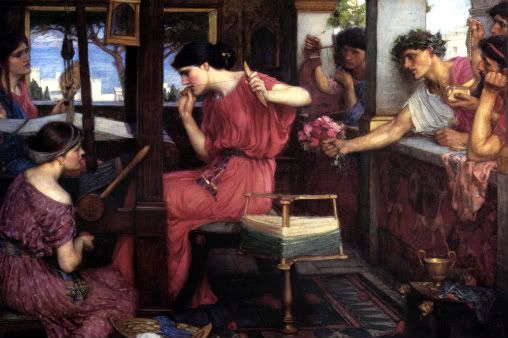
The Montreal Museum of Fine Art has just announced an exhibit of John William Waterhouse's work, set to open this fall.
The exhibit will run from October 1, 2009 through to February 7, 2010. The show was organized by the Groninger Museum in the Netherlands, with participation from the Royal Academy of Arts in London and the Montreal Museum of Fine Arts. It is expected to be the largest collection of his work ever on display, with paintings gathered from public and private collections across the globe. A number of the works have not been seen since Waterhouse's own lifetime.
I've been so excited by the recent increase in Canadian exhibits focusing on Pre-Raphaelite and Pre-Raphaelite related artists. Now, if only they'd do one in Edmonton! (Perhaps when our new Edmonton art gallery opens?).
For those of you living in the UK (or lucky summertime visitors), the exhibit can be seen at London's Royal Academy of Arts from June 27 - September 13, 2009.
Image: Penelope and the Suitors, John William Waterhouse, 1912
Posted by
Margaret
at
6:22 PM
7
comments
![]()
![]()
Labels: museums, news, pre-raphaelites, waterhouse
Wednesday, June 3, 2009
In Utero Beauty Pageant
Well, the past couple of weeks has just flown by! It's finally spring in Edmonton, and I am really enjoying going outside without a woolen overcoat (although nighttime temperatures still hover around freezing). My husband and I have been keeping busy with soccer matches and barbecues and revelling in the sunshine.
We had the big 19 week ultrasound last week, which was extremely exciting (albeit a bit uncomfortable--it's getting more difficult to drink all that water two hours before an exam). The baby is lovely. We already think she'll have her father's high cheekbones, thanks to a sneak peek at one of the 3D images. It's still a little strange to me to have all of these pictures. When I was a kid they didn't even do ultrasounds, although we do have an ultrasound of my little sister--I think they must have started doing them more regularly in the mid-eighties.
So, for the past week or so, I must confess that I've been comparing our baby's ultrasound photos to those of my friends' kids' ultrasounds, courtesy of facebook (everyone seems to post their ultrasound photos there). Of course, it may not have even been born yet, but our baby is by far the cutest.
I wonder if this sort of thing is common now? It has a sort of playground quality to it--you know, my blob is cuter than your blob? I guess that's something we never grow out of. Poor child, it hasn't even been born yet, and we're already trying to figure out what it's going to look like. Obviously, this wasn't really possible a few years ago. My baby sister's 2D ultrasound from back in the 80s is kind of a blur, but all of the images today seem so much clearer, whether 2 or 3D.
Now the attempt to rationalize my obsession with our unborn child's looks: I suppose that when you think about it, this must be something we do subconsciously before we even choose to have children. My mom's pet theory is that we are all subconsciously trying to improve our DNA, and we seek out partners that will fill the gaps so that our kids will be healthier and better looking. It's just one piece of the puzzle, but I must admit that it makes sense to me.
Anyway, we are in love with our little baby, no matter what it looks like, and I must say that I'm getting very excited to meet it!
Posted by
Margaret
at
8:23 AM
9
comments
![]()
![]()
Wednesday, May 20, 2009
Robert Bateman's Heloise and Abelard
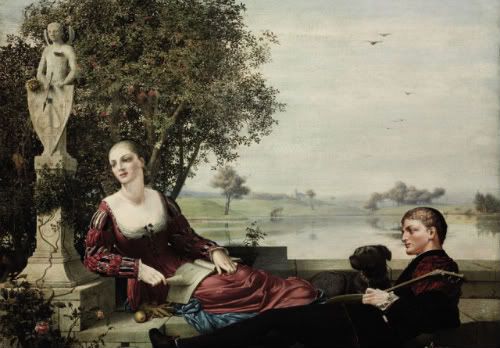
I ran across this painting while browsing Christie's website (hey, a girl can dream). It was pained by Robert Bateman(1842-1922), a lesser known artist who is considered more a member of the aesthetic movement than of the pre-raphaelite movement (i.e., he most likely preferred velvet knee-pants to medieval inspired garb).
Bateman was only known to have created 32 paintings during his career, and few have survived. His most well-known work, the Pool of Bethseda, was actually attributed to another artist with the same initials ( Richard Beavis )until 1965! His work has gained recognition over the past few decades as a result of its inclusion in several high-profile Pre-Raphaelite Exhibitions, including The Last Romantics, which appeared at the Barbican Art Gallery in 1989, and The Age of Rossetti, Burne-Jones and Watts: Symbolism in Britain 1860-1910, held at the Tate Gallery in 1997. Bateman was a tremendous fan of Edward Burne-Jones work and a accomplished artist in his own right, but he also pursued gardening and sculpture.
As for this painting, most people assume that the figures depicted are star-crossed lovers Heloise and Abelard, but nobody knows for sure, since Bateman didn't actually give a name to the picture himself. I'm interested to know what you guys think! I do think it's clearly a painting of two lovers whose time is running out. If you click to enlarge the painting, you'll see that Bateman has inscribed the phrase "carpe diem" near the base of the sundial. You will also note the dying sunflower draped over the sundial. (again, it's tough to think of two famous historical or fictional lovers whose time wasn't running out).
The painting is expected to fetch between £30,000 - £50,000 at auction ($46,350 - $77,250 USD).
For more information, visit Christie's website
Posted by
Margaret
at
8:40 AM
11
comments
![]()
![]()
Labels: edward burne-jones, pre-raphaelites
Wednesday, May 13, 2009
Attacking Suburban Sprawl in Vauban, Germany

I always find it incredibly depressing to drive from Edmonton to Calgary. It's starting to look like one unending stream of suburbs. While there are still plenty of wide, open spaces, they get smaller every year and the suburbs of both cities just keep on growing. I'm starting to wonder how long it will take before the three-hour drive between the cities evolves into a hellish tour of one giant housing development after another.
It's shocking what a tremendous amount of space these homes take up. They seem huge, which is of course a large part of their appeal. But at the same time, they are so close together that you can look in your neighbours windows! Even our flat has more privacy than that! You have to wonder why people don't just give up the pretence and share a wall with their neighbors. But I guess that violates the whole "my McMansion is my castle" mentality.
It's also pretty hard to imagine the suburbs without cars, but that is just what they have done in Vauban, Germany. Vauban has decided to take a new approach to suburban planning, creating friendly neighborhoods with easy access to public transportation. Parking one's car on the street is discouraged. And although car ownership is not forbidden, it is a bit of a pain (there are only two places to park in the entire town). As a result, 70 percent of residents have chosen to give up their cars. People either carpool or take public transportation. And because driving isn't really an option, small stores that cater to the pedestrian population thrive.
In addition, free standing homes are forbidden in Vauban, helping to eliminate a lot of wasted space (honestly, who really hangs out in the two square feet of land that separates houses from each other in these new developments? And why do they even bother putting windows on that side of the house, since the only thing you can look at is your neighbors siding (and maybe your neighbors, if you're lucky).
I really hope that this idea takes off, though there are some definite drawbacks to car-free living(especially where I live). Cars are lifesavers during the long Edmonton winter. When it's -30 C (-22 F for the Americans), you don't really feel like walking much of anywhere. Even if they grocery store is pretty close. So I guess I can see why suburban parking lots are so popular here. Still, I'm sure that things can be done to make developments more pedestrian/public transportation/bike-friendly. Hmm. What would William Morris do?
Image courtesy of Wikipedia.
Posted by
Margaret
at
8:17 AM
8
comments
![]()
![]()
Labels: architecture, environment, news
Wednesday, May 6, 2009
Ladurée Macarons
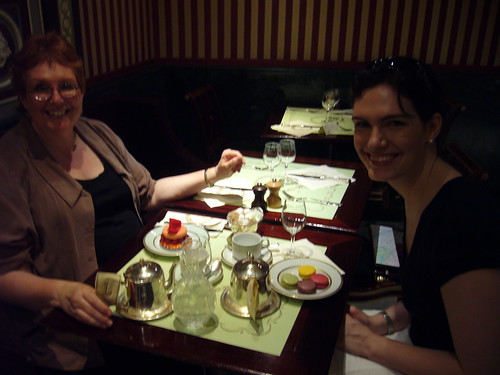
I haven't really had any cravings during my pregnancy, but if there's one thing that I can't stop thinking about lately, it's the lovely macarons (not to be confused with macaroons) from Ladurée. I think this is partly due to the empty Ladurée box sitting in my living room that I can't bear to part with. Everytime I see it I am transported back to memories of those heavenly, perfumed, morsels. I'm not usually one to get overly ecstatic about my food. I'm not a huge chocolate addict (don't get me wrong, I love chocolate, but I'm not one of those girls that "needs chocolate" or craves it particularly).
Anyway, there's just something about Ladurée's macarons that just sets them apart. But there doesn't seem a way to get them that doesn't involve a 9 hour flight (which, I suppose, is part of their charm). Anyway, I dearly wish that they would at least open one shop somewhere on this continent. Currently they have shops in Monaco, London, Tokyo and Switzerland. Would it kill them to open a shop in Seattle, San Francisco or Vancouver? Or even New York?
Hmm. Well, until then, I guess I'll just have to cherish the memories. And maybe try bribing friends to bring them back from overseas trips. And perhaps even learn to make a decent macaron myself!
Posted by
Margaret
at
8:14 AM
10
comments
![]()
![]()
Labels: france, gastronomy
Tuesday, April 28, 2009
A Baby Announcement!
Yes, yes, I have an announcement. My husband and I are currently expecting our first baby. Right now I'm 15 weeks and my husband and I are both extremely excited.
I have had an eerily symptom-free pregnancy. Aside from some tiredness and the occasional mood-swing (along with constant freaking-out-out-loud about the baby's health--thank you, Javier, for being so understanding!), I probably wouldn't have even known I was expecting! It's still a little shocking (and definitely reassuring) to go to the doctor's office and listen to the baby's heartbeat. It's very exciting, of course, but also a little hard to believe! (I've developed a lot more sympathy towards those women that claim they delivered a baby without even knowing they were pregnant).
The baby is due in October, and I must say I'm really looking forward maternity leave. Here in Canada we get an entire year, and I am so excited! Hopefully in between the sleepless nights I'll also have some more free time to blog and work on my writing--and maybe I'll even have some time to read!
I haven't decided yet if I will be starting a separate "baby blog" or not. I love reading other people's baby blogs, so I'm definitely toying with the idea. However, I'm not totally sure how much I'll have to say about motherhood! I guess we'll just have to wait and find out.
*Perhaps another symptom of pregnancy: I have started making up jokes in Spanglish, which make me laugh like crazy, even though I know it's positively loony. Early on in my pregnancy, I was watching Jeopardy with Javier and I got the answer (or is it the question?) wrong final Jeopardy answer wrong. In what I thought at the time was a brilliant bit of word play, I announced "yo perdi!" (Spanish for "I lost"), which sounds a lot like the word "Jeopardy." I think I laughed for an hour. Wow.
Posted by
Margaret
at
8:14 AM
19
comments
![]()
![]()
Tuesday, April 21, 2009
"Blood, Absinthe, and Aphorisms: New Currents in Aestheticism and Decadence"
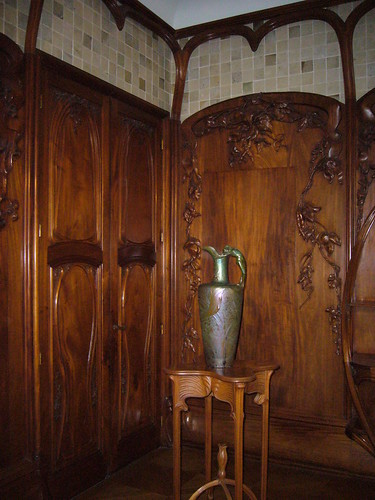
If you're lucky enough to be in New York city at the end of this month, be sure to check out "Blood, Absinthe, and Aphorisms: New Currents in Aestheticism and Decadence." The conference is being held free of charge with no prior registration required at the City University of New York, New York, NY from April 30- May 1, 2009.
The conference will be bringing together scholars from various academic backgrounds "to examine aestheticism and decadence in late Victorian literature, art, theater, politics, and popular culture." Reginia Gagnier will be this year's keynote speaker and the opening roundtable will examine "What's New in Decadence and Aestheticism." Other speakers include Dennis Dennisoff, Joseph Bristow, Linda K. Hughes, Richard Dellamora, and Margaret D. Stetz. Topics covered include presentations on C. R. Ashbee and British utopias, Sarah Bernhardt, Oscar Wilde, and romanticism; Aubrey Beardsley and the art of the poster (that one sounds like a lot of fun!); Edward Carpenter and domestic interiors, and Black decadence in the work of M. P. Shiel.
The conference will be held at the Graduate Center, 365 Fifth Avenue, New York, NY.
For more information, check out the conference's website.
Posted by
Margaret
at
8:21 AM
9
comments
![]()
![]()
Tuesday, April 14, 2009
Sin and Salvation: Holman Hunt and the Pre-Raphaelite Vision
For those of you in the Toronto area who have not yet had the chance to visit the Art Gallery of Ontario's current Pre-Raphaelite exhibit, there's still time! "Sin and Salvation: Holman Hunt and the Pre-Raphaelite Vision" will be running until May 10, 2009. Sixty of William Holman Hunt's paintings are on display at the exhibit, including Isabella and the Pot of Basil, The Awakening Conscience and The Light of the World. 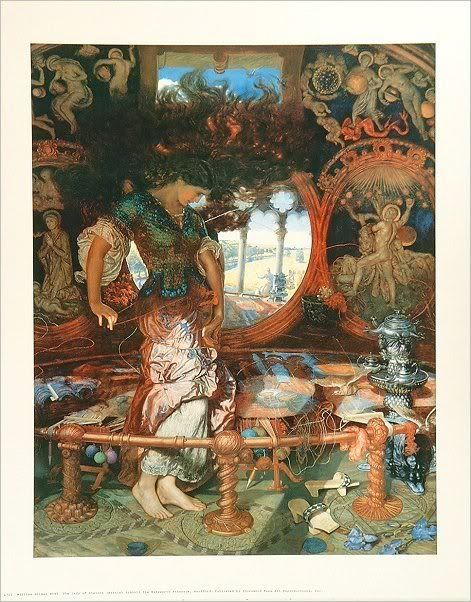
In addition to the paintings, the museum is also displaying the costumes that Hunt and his family used to pose for artworks (Hunt himself used to enjoy dressing up while he was painting--I saw a great photograph of him a while ago in full safari getup while he was painting The Scapegoat). It sounds like an amazing exhibit. I only wish I lived closer to Toronto!
For more information on the exhibit, please visit the Art Gallery of Ontario's website.
Posted by
Margaret
at
8:20 AM
13
comments
![]()
![]()
Labels: news, pre-raphaelites, william holman hunt
Tuesday, March 31, 2009
Andrew Lloyd Webber Announces Sequel to Phantom of the Opera
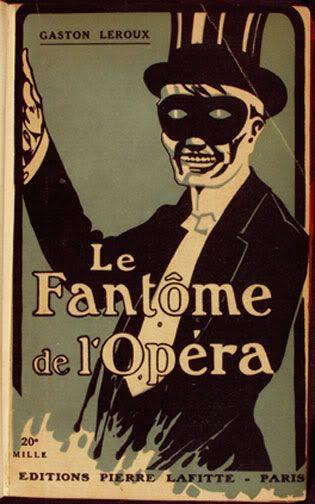
Sir Andrew Lloyd Webber has been busy working away at a sequel to his 1986 hit, The Phantom of the Opera. The sequel, entitled Love Never Dies, will premiere in London this fall and is slated for production in Toronto and Tokyo shortly thereafter.
Love Never Dies is set in Coney Island (of all places), and features an older Christine, her husband Raoul and son Gustav. Christine agrees to a "one night only" performance and everything goes terribly wrong...
I fell in love with Phantom of the Opera when I was fifteen. I heard the soundtrack to the musical at my friend Alisa's house and was entranced. After that I even managed to get my hands on the original book by Gaston Leroux, which I highly recommend, even though it's quite different from the musical. The book has a very recognizable Victorian Gothic quality to it, and reminds me a lot of Bram Stoker's Dracula (the writing style is very similar).
I'm looking forward to the new show, though I have my reservations about the Coney Island setting (which will probably be delightfully macabre). The music has already been recorded on a concept album, though no word yet on when the album will actually be available for sale. The word is that it might be released before the premiere, but I rather doubt it.
What do you guys think about a sequel to Phantom of the Opera? Would you be excited to see it? Are you worried that Andrew Lloyd Webber will damage the legacy of Phantom of the Opera with a sub-par sequel? Please weigh in.
You can read more about Webber's upcoming production on broadway.com.
Image courtesy Wikimedia.
Posted by
Margaret
at
8:08 AM
11
comments
![]()
![]()
Thursday, March 5, 2009
A Good Children's Book is Hard to Find
I love illustrated children's books. When I was a little girl, my mother had a tremendous collection of gorgeous illustrated books that she would read to me. Now that I'm older, I can't help but to acknowledge what a profound effect they must have had on me. Through those books, I gained a life-long appreciation for beautiful art and beautiful words.
I'm not sure if my mother was just exceptionally gifted at finding beautiful books (which of course she was), or if children's books were just a lot better then (which I think they probably were). Whatever the case may be, I just have a very hard time finding well-written, beautiful children's books.
Yesterday I spent over an hour at our local independent bookseller and could not find a single book that I thought was worth getting. It was majorly depressing. I went through every single shelf in their children's department and I couldn't find anything that really spoke to my soul. Some of the books were okay (who doesn't love "The Hungry Caterpillar"?), but they certainly didn't speak to my imagination. The illustrations were either banal or downright bad. I did find some books by Demi Hitz which were quite pretty, and I was a little bit tempted by them. But overall, nothing really stood out. Oh...I also found a copy of "Bread and Jam for Frances", by Russell and Lillian Hoban, which I also love. (By the way, do any of you remember the Caldecott medals they used to have for kids books? Do they still do that in the States? I have not seen any awards on kids books here in Canada, though I'm not surprised, as the choice here seems pretty dismal).
My husband picked me up afterwards and we had a long conversation about the whole experience in the car. I decided that for now I'll just collect used illustrated children's books, and if I want to get good books for very young children, I may just have to write them myself! I'm ready to run out and get some coloured pencils and have at it...
Does anyone else with young children ever feel like there are no books for children that are worth reading? I would love to know if any of you have found great new children's books recently!
Posted by
Margaret
at
8:32 AM
23
comments
![]()
![]()
Labels: books, fairy tales
Sunday, February 8, 2009
Cast of "Desperate Romantics" announced by the BBC
The BBC Press Office has finally released the casting information for their upcoming series, Desperate Romantics. Most of the actors historically inspired TV dramas are much better looking than their historical counterparts and I'm not complaining. However, the BBC definitely took some rather extreme artistic liberties with this one.
First up: Dante Gabriel Rossetti will be played by Aiden Turner. We all know that Rossetti was a bit of a lady killer, but he wasn't exactly top model material. The producers have chosen to gloss over this a bit and have chosen an impossibly attractive young man to play Rossetti. While I fail to see much of a resemblance between him and Rossetti (other than the fact that both of them have brown hair!), I'm pretty sure Rossetti would approve. After looking at his photograph, take a look at his self-portrait. Rossetti doesn't seem to have had a problem with portraying himself as more attractive than he actually was (though, in his defence I'm sure years of drug abuse had taken a toll on his boyish good looks in this photo).
Dante Gabriel Rossetti, in the flesh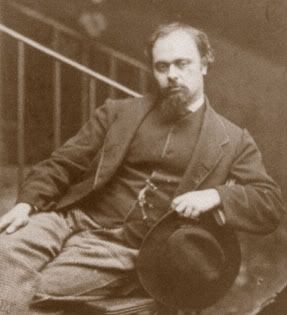
Rossetti's self portrait: 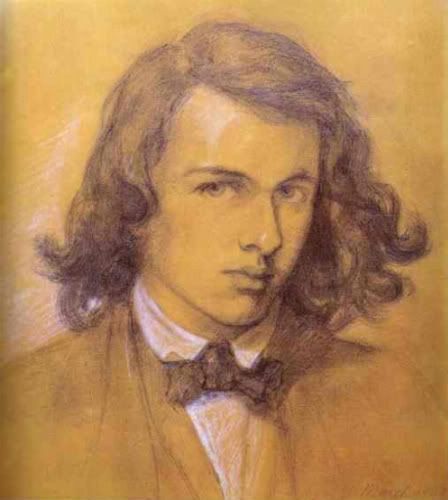
And finally, his cinematic alter ego : 
Correction: it's not that Aidan Turner, it's this one:
(And thank you to whoever pointed out which Aidan Turner will actually be starring in Desperate Romantics! A little less soap-opera-ish and a lot more believable.)
And now for the rest of the cast.
Tom Hollander (who bears little resemblance to John Ruskin--for one thing, he's a bit chubby and Ruskin was practically anorexic) will be playing Ruskin, the famous art critic and patron of the Pre Raphaelites. This casting decision still makes sense to me,though, as Hollander often plays snobby, self-absorbed types. At the same time, I hope he doesn't overdo it. Ruskin was certainly interesting, even if he was obsessed with his work and had a rather odd way of relating to women.
In more casting news, Samuel Barnett will be playing John Millais, and Zoe Tapper will be playing Effie Ruskin (who later leaves Ruskin to be Mrs. Millais).
Amy Manson has been cast as Pre-Raphaelite "stunner" Lizzie Siddal, Sam Crane as Fred Walters and Jennie Jacques will play Annie Miller. Rafe Spall will also take a turn as PRB founding member William Hunt.
All in all, I predict that the script will be frothy melodrama and the cast will be easy on the eyes. Not a problem, as far as I'm concerned. There's no denying that the Pre-Raphaelites are ripe for soap opera-esque treatment. I just hope that the series will revive public interest in the Pre-Raphaelite and Arts and Crafts movements.
Posted by
Margaret
at
10:14 AM
20
comments
![]()
![]()
Labels: lizzie siddal, pre-raphaelites, rossetti, ruskin, william holman hunt
Tuesday, January 20, 2009
An Historic Inauguration
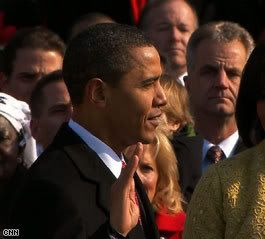
This was a special day for me as an American, but perhaps even more so as an American living abroad. American ex-pats are often rather shy about confessing their nationality. My husband and I went to a party two years ago, and when one of the couples at our table found out I was an American, they excused themselves(they didn't care what my politics were--they did not want to sit next to an American). Of course, I was a little offended, but I wasn't that surprised. Like it or not, the last 8 years have been pretty tough on America's image, and noone feels this more keenly than those of us who live abroad. A lot of people just don't like us, and many of them have their reasons.
The funny thing is, as soon as Obama declared his intention to run for president, world opinion started to shift. And by the time I went to France this summer, the whole world was talking about the possibility that Americans might elect the first president in the western world that was a member of a visible minority. There was also a tacit understanding that electing the first black president of the United States was a vital step in healing our country's image and removing the stain of inequality that had marred our reputation around the world.
Actions speak louder than words, and President Obama will be faced with tremendous challenges. But as he often reminds us, Obama's mere presence in this office demonstrates that the Americans are truly committed to the belief that all men are created equal. And although I live in Canada, this ex-pat is feeling quite patriotic today.
Image courtesy CNN
Posted by
Margaret
at
11:47 AM
14
comments
![]()
![]()
Labels: news
Monday, January 19, 2009
Belmont Lodge, an historic building with ties to the Pre-Raphaelite Movement, is threatened with demolition
Belmont Lodge, an historic building in Bognor Regis with ties to the Pre-Raphaelite movement, has been threatened with demolition.
The lodge, which dates back to the Regency period, was the home of William Shakespeare Burton. Burton's best-known Pre-Raphaelite-inspired work is The Wounded Cavalier."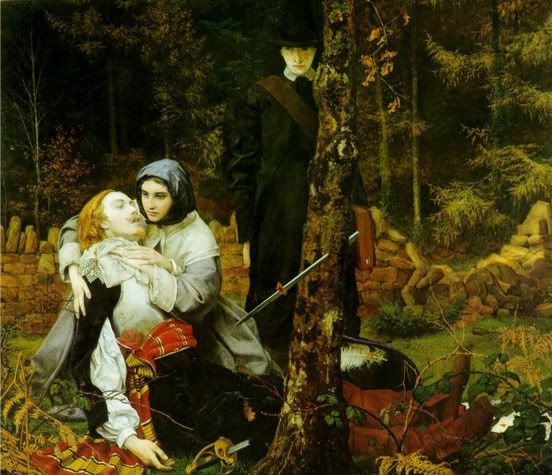
Dante Gabriel Rossetti stayed in the Lodge's former coach house for a year, during which he produced as many as ten paintings, including the famous Astarte Syriaca.
It is currently being proposed that the lodge be torn down and an apartment complex erected in its place. What a shame. Let's hope that people in the area make a fuss about the plans, though I'm not sure how likely that is, since the building is neither well-known, nor listed as an historic building.
You can read more about the proposal in the Bognor Regis Observer.
Image: "The Wounded Cavalier," by William Shakespeare Burton, 1855.
Posted by
Margaret
at
10:17 AM
4
comments
![]()
![]()
Labels: news, pre-raphaelites, rossetti
Wednesday, January 14, 2009
Desperate Romantics by Franny Moyle

Franny Moyle's new book, Desperate Romantics, catalogues the lives and loves of the Pre-Raphaelites, while occasionally touching on their art. The book, which serves as the inspiration for the upcoming BBC miniseries of the same name, sounds like it will be a delight for those looking to dwell on the shallower aspects of the Pre-Raphaelite movement.
First, I will confess that the bohemian lifestyle of the Pre-Raphaelites has held a certain fascination for me ever since I first picked up Beth Russell's Traditional Needlepointand suddenly found myself entranced by the beauty of Morris and Rossetti's art and the sordid details of their personal lives. Whether for good or ill, the countless affairs, intrigues, love triangles and suicides that pepper the Pre-Raphaelite movement have undeniably added to their allure.
It still seems a shame that the book ignores the Pre-Raphaelites' art almost entirely, in favour of tabloid coverage of their exploits. There is so much more to the Pre-Raphaelite vision than sultry models and randy artists. William Morris himself was a fascinating man with beautiful ideas that are still pertinent today. The same is also true for the inspiring John Ruskin, who is sidelined as a mere deviant in Moyle's work. In her defence, however, I notice that Moyle is a television producer, which probably explains her conviction that sex is the best way to sell art. And perhaps she's right. It certainly worked for me. Today my interest in the Pre-Raphaelites goes far beyond their sordid personal lives, but in the beginning, their fascinating lives were instrumental in drawing me into their world.
For more information, read the Times review of Desperate Romantics
Posted by
Margaret
at
10:28 AM
8
comments
![]()
![]()
Labels: books, jane morris, news, rossetti, ruskin, william morris
Friday, January 9, 2009
Waterford and Wedgwood in Receivership
Most of you have probably heard by know that Waterford Wedgwood PLC is now in receivership. In November I wrote about Spode's financial troubles and it now appears that Waterford/Wedgwood are going through similar difficulties.
There are a number of potential buyers in the works for Waterford Wedgwood, but this still doesn't really answer the question of what will happen to this historic company once it has been split into pieces and sold to the highest bidder.
It's a real shame that so many historic businesses have been hard hit by the financial crisis. Of course, part of the problem is that many of them have sacrificed the quality of their products and left their customers feeling betrayed. While this may save on costs in the short-term, luxury brands simply cannot afford to sully their reputations by cutting corners with their products. I don't think this has necessarily been the problem with Waterford, which has apparently refused to outsource their production to Indonesia (could this perhaps be a "damned if you do, damned if you don't" scenario).
While both Waterford and Wedgwood have existed since the 17th century, the marriage of the two occurred in 1986, when Waterford purchased Wedgwood.
In spite of all this doom, there is a bit of cheery news. According to the New York Times this is not the first time that Waterford has been in....well...hot water. Apparently Waterford was forced to close its doors for more than 100 years in 1851 when rising taxes made the business unprofitable. Perhaps these companies will emerge, stronger than ever, once the economy turns around. Let's hope so.
Posted by
Margaret
at
2:17 PM
6
comments
![]()
![]()
Labels: news

